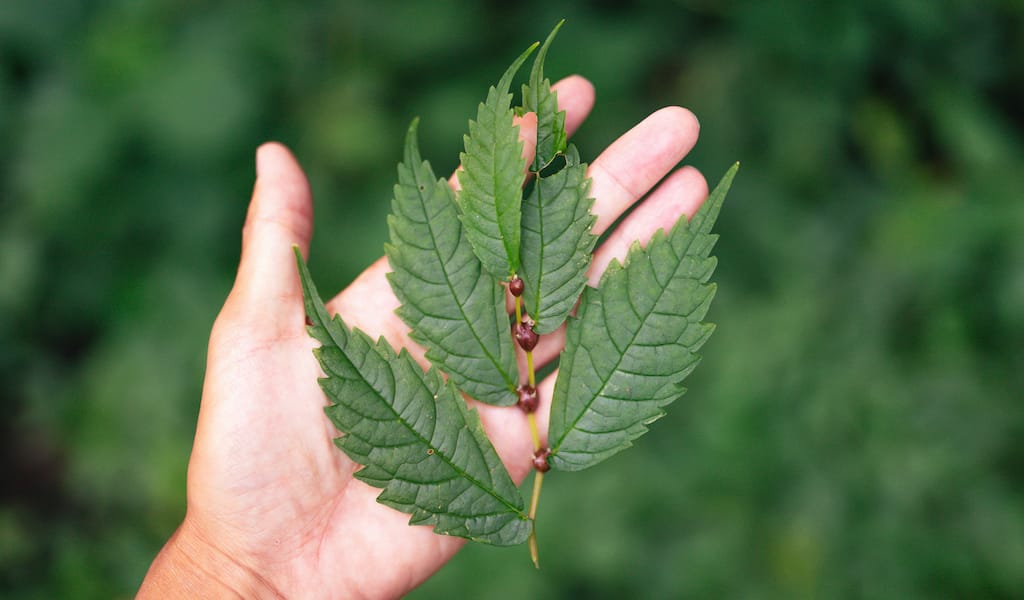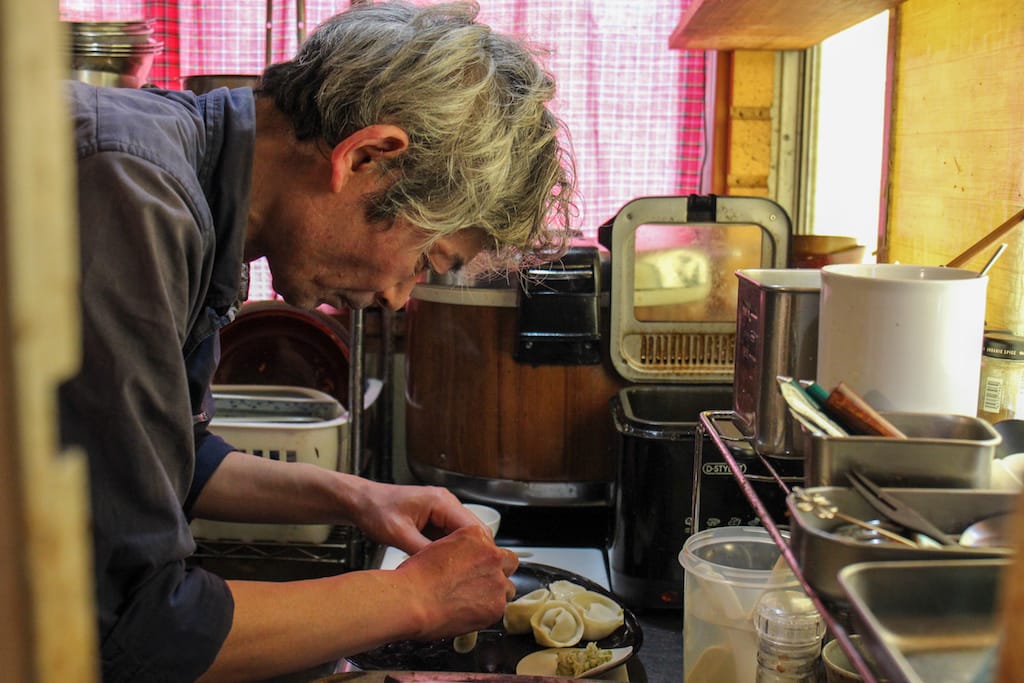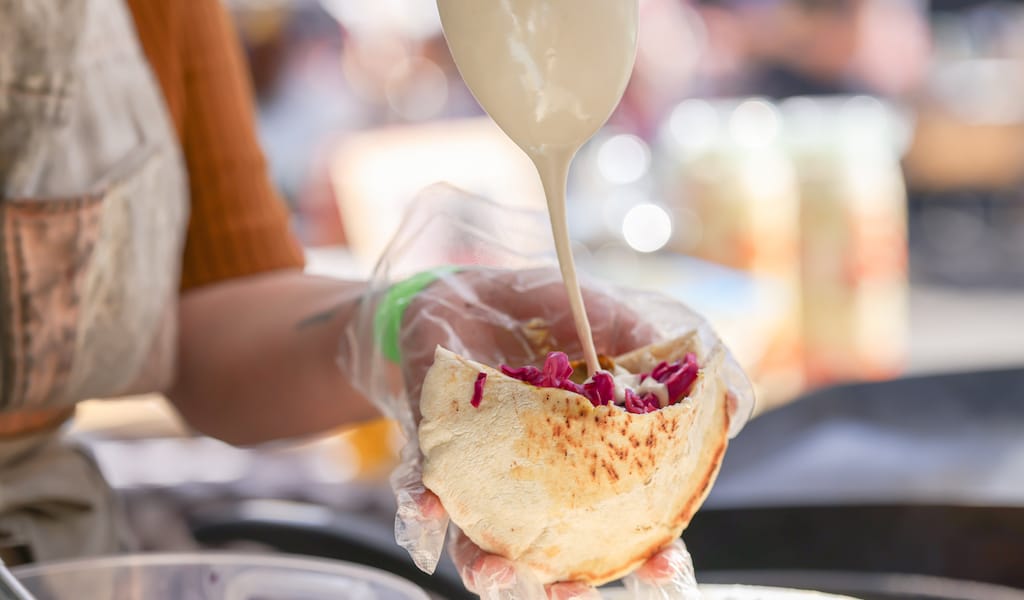Much has been written about the yamabushi of the Dewa Sanzan mountains in Yamagata Prefecture, about two and a half hours north of Tokyo via bullet train. The yamabushi are followers of Shugendo, an ascetic mountain religion best thought of as an amalgamation of Shinto, Buddhism, Taoism, and mountain worship. Shrouded in secrecy and more than a little mystery, their ascetic practices might seem more like superhuman feats to the layperson: yamabushi famously commit to often physically grueling, spiritual practices of self-denial, like circumambulating mountains on straw sandals year-round, or meditating for hours under freezing waterfalls.
Food might not seem of great importance while in pursuit of enlightenment, but it turns out that what you eat in your spiritual practice is just as important as your other activities. So we’ve travelled to Saikan, a temple-lodge at the top of Mt. Haguro, one of the three sacred mountains of Dewa Sanzan for a taste of what the yamabushi eat – shojin ryori (精進料理).
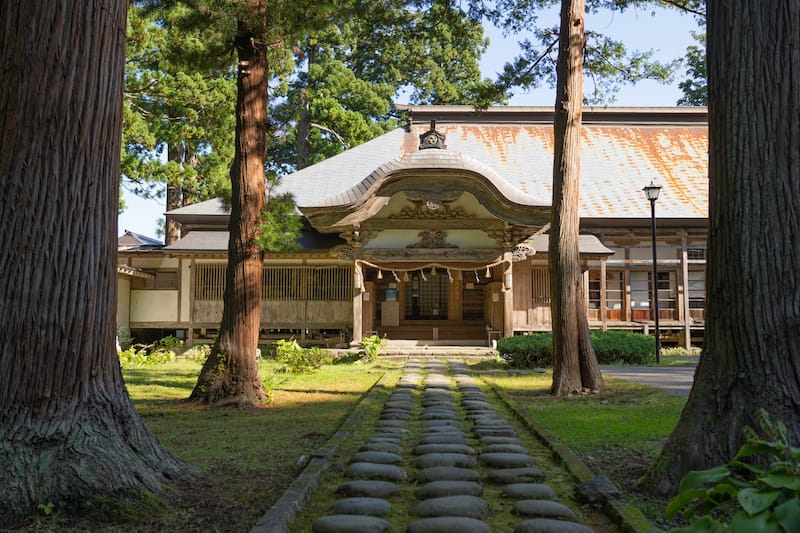
Shojin ryori is commonly defined as Buddhist vegetarian cuisine. The characters for shojin (精進) can variously be understood as “devotion,” “asceticism,” “earnest effort” or even “cultivation.” In other words, this is cuisine for those involved in these practices. In accordance with Buddhist prohibitions against killing, shojin ryori is (typically) entirely plant-based; the cooking techniques developed at Buddhist temples also had a tremendous and lasting influence on the evolution of kaiseki cuisine – traditional Japanese multi-course meal with roots in tea ceremony.
Saikan is (justifiably) famous for its shojin ryori. In the last decade, it’s attracted scores of visitors who have climbed Mt. Haguro less for the act of pilgrimage than for a meal at this inn. There are few better people to speak to about this than head chef Shinkichi Ito, who has dedicated the last 25 years to the craft of shojin ryori at Saikan.
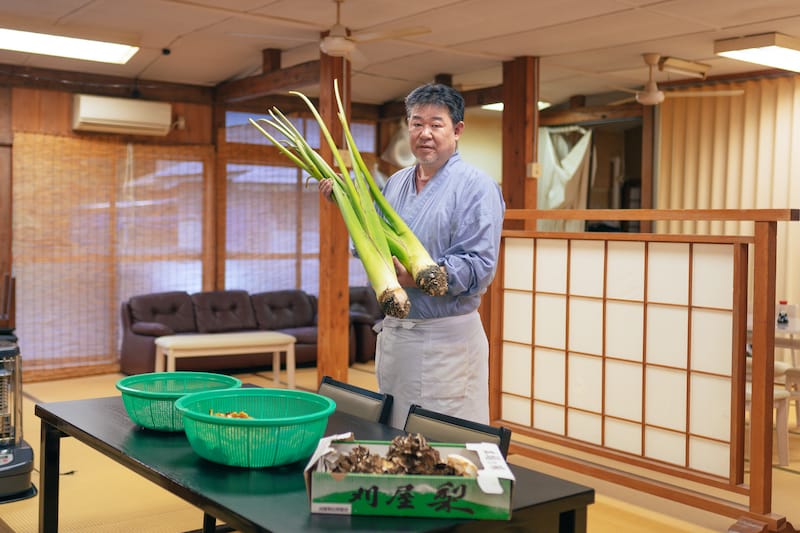
Meals here are unlike the oddly refined and immaculate shojin ryori set meals you see at temples in Kyoto. The goma dofu (sesame tofu), a staple of virtually all shojin ryori meals, is given a Yamagata twist: a blanket of sweet, viscous ankake sauce that’s a nod to traditional foods at local festivals. More importantly, the meals feature a frequently changing array of uncommon, locally foraged sansai (mountain vegetables) across the season. During our visit, there’s akebi (chocolate vine, or akebia quinata), whose bitter skin we eat simmered in miso; bunakanoka (Mycoleptodonoides aitchisonii), a chicken-like mushroom with a delicious bite; the stems and buds of akamizu (elatostema umbellatum var. najus), a flowering plant in the nettle family.

“It’s about this earth, this water, the things that were grown right here,” says Ito, when asked what sets Dewa Sanzan’s shojin ryori apart from other places. “It’s all about this particular mountain, not somewhere else.”
In other words, it’s terroir – the idea that geography and climate imbue the food with a distinctive, location-specific character – overlaid with spiritual practice.
Central to this particular form of shojin ryori is the notion of consuming the plants growing here, and thus receiving the spiritual energies and blessings from this sacred mountain. The cuisine likely began as a matter of survival, foraging and painstakingly building up knowledge on what was edible and what wasn’t. Gradually, efforts turned towards coaxing a delicious meal out of these often-bitter plants, honing a variety of cooking techniques and treatments.
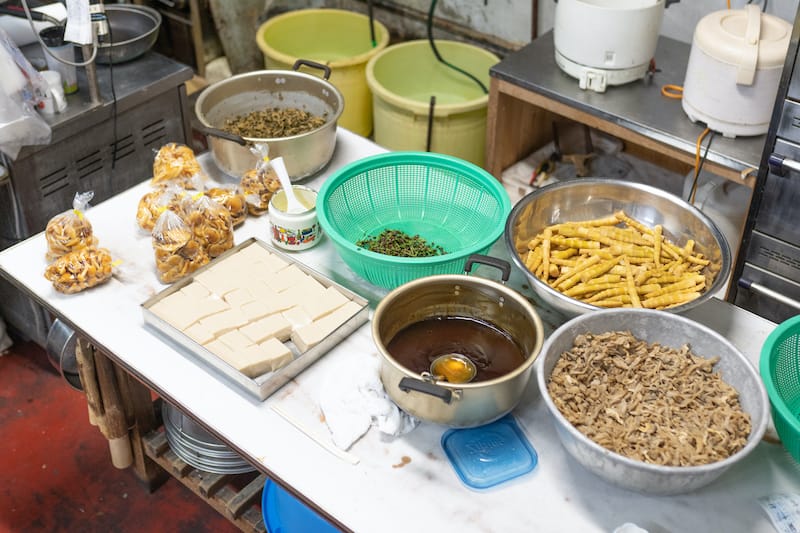
Saikan’s cuisine stays true to the spirit of yamabushi practice: the majority of their dishes consist of wild mountain plants, supplemented by ingredients like rice or soybean products sourced from the surrounding Shonai area. Because of Shinto influences, fish can and does turn up at mealtimes – fish is often offered to the gods in Shintoism – and the dinner served to guests is a “celebratory” form of shojin ryori eaten after completing a pilgrimage or period of spiritual practice.
It’s about this earth, this water, the things that were grown right here.
How does someone become a shojin ryori chef? In Ito’s case, sheer providence. Before Saikan, he worked at a mountain lodge on neighboring Mt. Gassan, one of the three holy mountains of Dewa, alongside Mt. Haguro and Mt. Yudono. He would watch yamabushi pass by, dressed in their white garb with large horagai shells hanging round their necks, and wonder what they ate to purify themselves. Then the head of a shrine on Mt. Haguro invited Ito to take over the kitchen at Saikan, and the rest is history.
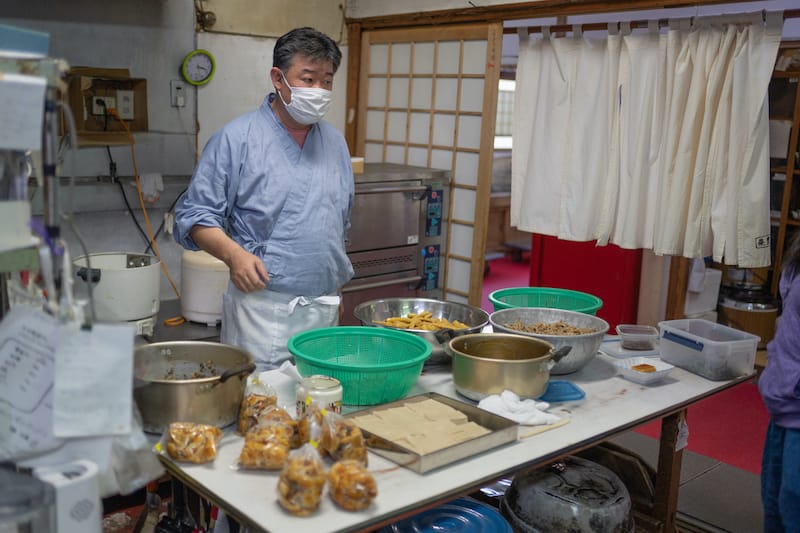
Ito has never had formal training in shojin ryori. In that sense, his path was not dissimilar to the earliest yamabushi. According to Ito, there was no formal framework for local shojin ryori, forcing him to rely on other people’s taste memories and lived knowledge of the cuisine that came before. He studied old methods from what little records remained, testing and refining cooking techniques. Above all, the mountain was his greatest teacher, as he became familiar with the flora and fauna of this place through other local foragers.
Over the years, Saikan has also incorporated ingredients, approaches, and techniques picked up from other chefs and cooking styles, while staying true to its spirit. It’s crucial to adapt shojin ryori to modern palates, he says. It’s impossible to please everyone, but he manages to cater to a wider range of people, adapting courses and dishes to suit different demographics.
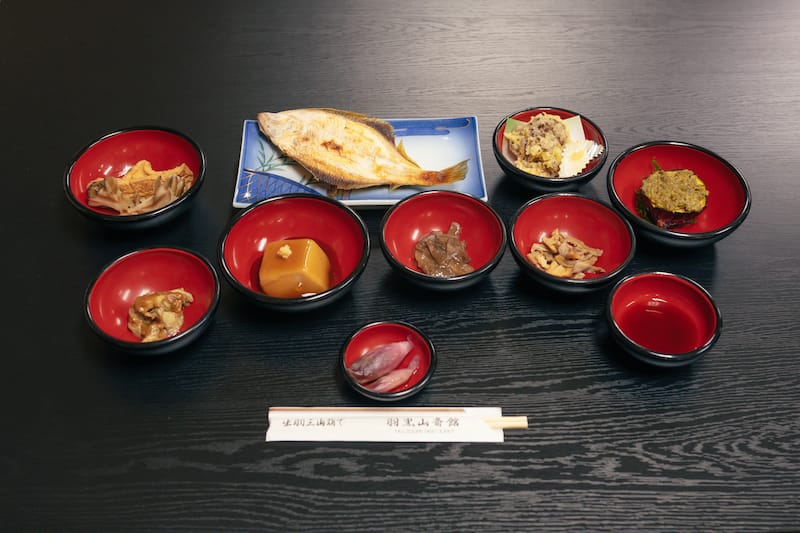
“The food I used to cook was much saltier and more strongly flavored to meet the physical needs of the yamabushi,” explains Ito, who has not been content to let the cuisine ossify. “I take the recipes from long ago and adjust them to suit the people of today.”
An obvious example of modern shojin ryori appears at breakfast: a vinegared dish of itadori (Japanese knotweed, or Fallopia japonica) and fresh tomatoes. Tomatoes are hardly a traditional Japanese ingredient (or indeed foraged food) but its acidity pairs well with itadori’s rhubarb and celery notes.
One of the great charms of such place-specific shojin ryori is that the food is a hyper-local expression of the seasons in the surrounding mountains. In spring, the dishes are largely shades of vibrant green; autumn signals the arrival of warmer colors and flavors, thanks to all the mushrooms popping up in the woods.
We get a taste of the foraging life after breakfast on this mild, late summer morning. He takes us a short distance from the entrance of Saikan, and points us to large clumps of green leaves next to the stone-paved hiking path. This turns out to be akamizu, a mountain plant whose buds we ate this morning; they were crisp and succulent, with an allium-like finish.
Our task is to pick only the stems with dark red buds attached; these turn a dark green when dropped into boiling water. It’s laborious work: you snip off stems and discard the leaves, which takes much longer than expected. If I’d kept at it for an hour, I’d have just a scant handful to show for my efforts. Still, there’s a certain magic in being able to pluck food from the forest floor, and I find myself looking around afterwards, wondering what else we could be eating if we learned to look beyond the supermarket shelves.
Operating Saikan is hard work. Ito and his staff are often awake by 4 a.m. on most days, grinding sesame for tofu, prepping vegetables, and foraging in the mountains before the sun is high. But fundamentally, he says, his feelings about shojin ryori haven’t changed – he’s still driven by a desire to keep this culinary culture alive, and for more people to experience the food of this mountain.
“This isn’t the sort of work you can do if you think of it as a job,” Ito says. “You have to really love it to do it. And this is just a way of living for me.”
Photos were kindly supplied by Derek Yamashita.
Published on September 14, 2022
Related stories
August 5, 2022
TokyoDaiji Takada, owner of Chabuzen, peeks out over the counter from the kitchen, which has about a meter-long strip of standing space for one at most. The interior of this narrow restaurant, tucked away in the very fringes of the hip neighborhood of Shimokitazawa in western Tokyo, isn’t much more spacious. Two low tables on…
March 14, 2022
Los Angeles | By Ben Mesirow
Los AngelesCauliflower shawarma, lentil arayes and a killer sabich – Amit Sidi is cooking some of the best vegan food in town at B’Ivrit, her Israeli street food pop-up. Amit is not vegan. She’s not a trained chef either. But she rolls up to bars around northeast LA – and Smorgasburg every Sunday – offering an…
August 1, 2023
Tokyo | By Florentyna Leow
TokyoOn a warm August morning two years ago in an orchard somewhere west of Aomori City in Japan’s Tōhoku region (about 4 hours from Tokyo by train), we watched blackcurrant farmer Kenji Hayashi scoop dark magenta gelato into paper cups. Ribena had nothing on this. It tasted like summer incarnate, an electric blackcurrant explosion tempered with…







































